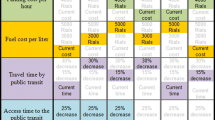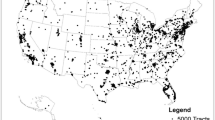Abstract
Automobile use leads to external costs associated with emissions, congestion, noise and other impacts. One option for minimizing these costs is to introduce road pricing and parking charges to reduce demand for single occupant vehicle (SOV) use, while providing improvements to alternatives to encourage mode switching. However, the impact of these policies on urban mode choice is uncertain, and results reported from regions where charging has been introduced may not be transferable. In particular, revealed preference data associated with cost recovery tolls on single facilities may not provide a clear picture of driver response to tolls for demand management. To estimate commuter mode choice behaviour in response to such policies, 548 commuters from a Greater Vancouver suburb who presently drive alone to work completed an individually customized discrete choice experiment (DCE) in which they chose between driving alone, carpooling or taking a hypothetical express bus service when choices varied in terms of time and cost attributes. Attribute coefficients identified with the DCE were used in a predictive model to estimate commuter response to various policy oriented combinations of charges and incentives. Model results suggest that increases in drive alone costs will bring about greater reductions in SOV demand than increases in SOV travel time or improvements in the times and costs of alternatives beyond a base level of service. The methods described here provide an effective and efficient way for policy makers to develop an initial assessment of driver reactions to the introduction of pricing policies in their particular regions.
Similar content being viewed by others
References
Burris MW (2003). The toll-price component of travel demand elasticity. International Journal of Transport Economics 30(1): 45–59
DeCorla-Souza P and Kane AR (1992). Peak period tolls: Precepts and prospects. Transportation 19: 293–311
Dunne JP (1984). Elasticity measures and disaggregate choice models. Journal of Transport Economics and Policy 18: 189–197
Ewing G & Sarigollu E (1998) Car fuel-type choice under travel demand management and economic incentives. Transportation Research D 3: 429–444
Flannelly KJ, McLeod MS, Flannelly L and Behnke RW (1991). Direct comparison of commuter’s interests in using different modes of transportation. Transportation Research Record 1321: 90–96
Greene WH (1998). LIMDEP Version 7.0. Econometric Software Inc, Plainview
Hagler Bailly Ltd. (1999) The Potential of Fuel Taxes to Reduce Greenhouse Gas Emissions in Transportation. Transportation Table Study No. 3, National Climate Change Process
Higgins TJ (1997). Congestion pricing: public polling perspective. Transportation Quarterly 51: 97–104
Hirschman I, McKnight C, Pucher J, Paaswell R and Berechman J (1995). Bridge and tunnel toll elasticities in New York. Some recent evidence. Transportation 22: 97–113
Hug K, Mock-Hecker R and Wurtenberger J (1997). Transport demand management by electronic fee collection in a zone-based pricing scheme. The Stuttgart MobilPASS field trial. Transportation Research Record 1576: 69–76
Hunt JD and McMillan JDP (1997). Stated preference examination of attitudes toward carpooling to work in calgary. Transportation Research Record 1598: 9–17
Koppelman FS, Bhat CR and Schofer JL (1993). Market research evaluation of actions to reduce suburban traffic congestion: commuter travel behaviour and response to demand reduction actions. Transportation Research A 27(5): 383–393
KPMG Peat Marwick Stevenson Kellogg (1993) The cost of transporting people in the British Columbia Lower Mainland. Background report prepared for the Greater Vancouver Regional District as part of Transport 2021
Kuppam A, Pendyala R and Gollakoti M (1998). Stated response analysis of the effectiveness of parking pricing strategies for transportation control. Transportation Research Record 1649: 39–46
Larsen OI and Ostmoe K (2001). The experience of urban toll cordons in norway. Lessons for the future. Journal of Transport Economics and Policy 35(3): 457–471
Litman T (2001) Online Transportation Demand Management Encyclopaedia. Victoria Transportation Policy Institute
Litman T, Komanoff C, & Howell H (1998) Road Relief: Tax and Pricing Shifts for a Fairer, Cleaner, Less Congested Transportation System in Washington. Energy Outreach Center
Louviere J, Hensher D and Swait J (2000). Stated Choice Methods, Analysis and Applications. Cambridge University Press, Cambridge
McFadden D (1974). Conditional logit analysis of qualitative choice behaviour. In: Zarembka, P (eds) Frontiers in Econometrics, pp. Academic Press, New York
O’Mahony M, Geraghty D and Humphreys I (2000a). Distance and time based road pricing trial in Dublin. Transportation 27: 269–283
O’Mahony M, Geraghty D and Humphreys I (2000b). Potential response to road user charging in Dublin, Ireland. Transportation Research Record 1732: 50–54
Oum TH, Waters WG and Yong J-S (1992). Concepts of price elasticities of transport demand and recent empirical estimates. Journal of transport economics and policy 26: 139–154
Pickrell D (1999). Cars and clean air: a reappraisal. Transportation Research Record Part A 33: 527–547
Polak J, Jones P, & Vythoulkas P (1991) The Trondheim Toll Ring: Results of a Stated Preference Study of Travelers’ Responses Deliverable 17, Transportation Studies Unit University of Oxford and Solveig Meland Terje Tretvik, Division of Transport Engineering, SINTEF, Trondheim Norway
Toh RS and Phang S-Y (1997). Curbing urban traffic congestion in Singapore: A comprehensive review. Transportation Journal 37(2): 24–33
TransLink (2000) Regional Travel Survey. GVRD Results. TransLink Marketing Department and Canadian Facts
Transport for London (2003) Congestion Charging: Six Months On October 2003
Washbrook K (2002) Assessing the Potential of Road and Parking Charges to Reduce Demand for Single Occupancy Vehicle Commuting in the Greater Vancouver Region. Report No. 298, School of Resource and Environmental Management, Simon Fraser University, June 2002
Author information
Authors and Affiliations
Corresponding author
Rights and permissions
About this article
Cite this article
Washbrook, K., Haider, W. & Jaccard, M. Estimating commuter mode choice: A discrete choice analysis of the impact of road pricing and parking charges. Transportation 33, 621–639 (2006). https://doi.org/10.1007/s11116-005-5711-x
Published:
Issue Date:
DOI: https://doi.org/10.1007/s11116-005-5711-x




